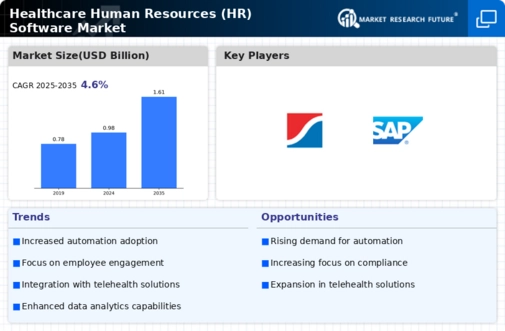Market Analysis
In-depth Analysis of Healthcare Human Resources Software Market Industry Landscape
The dynamics of the Healthcare Human Resources (HR) Software Market are shaped by the evolving healthcare landscape, the need for workforce optimization, and the integration of technology to streamline HR processes in healthcare organizations. Stakeholders in the healthcare industry, including hospitals, clinics, and healthcare management systems providers, must navigate these dynamics for effective talent management, compliance, and improved operational efficiency. The overall transitioning of the sector towards digitization has greatly impacted dynamics. Digital solutions such as HR software are widely accepted in the industry to improve operations by modernizing them, make data more accurate and keep workforce management compliant with regulations. Among the dynamics, they have to include dealing with talent gap and workforce problems. HR software helps organizations to engage, recruit and retain the skilled healthcare professionals necessary for coping with shortages of those needed workers as well as managing such a complex workforce. Compliance management determines dynamics. Healthcare HR software provides a crucial role in compliance with strict regulations, including healthcare privacy laws (HIPAA), labor legislations and accreditation standards avoiding the unpleasant consequences of legal proceedings and fines. The dynamics include better hiring and orientation procedures. HR software simplifies recruitment process cycle from job posting to candidate tracking, and onboarding where hiring of employees is done quickly hence their integration into healthcare institutions becomes effortless. Dynamics are the integration with EHR systems. HR software and EHR systems are made to work together seamlessly, which improves data interoperability; this allows for a broader overview of employee records with much better coordination between clinical staff and administrative personnel bearing in mind the enhancement of quality patient care. The involved dynamics take the form of workforce analytics. With HR software, healthcare organizations have access to powerful analytics tools that make it possible for them to base their workforce planning decisions on hard facts; also, with the help of such a tool they can allocate resources more strategically and optimize performance effectively. The dynamics are affected by an emphasis on employee engagement and retention. The ability of HR software to drive strategies that increase employee satisfaction, quantify engagement levels and address retention issues promotes positive work culture in healthcare organizations. The dynamics are encompassed by training and development programs. HR software assists healthcare organizations in developing training programs, monitoring employee certifications and continuous professional development leading to a highly qualified and knowledgeable workforce. Dynamics are such things as the migration to cloud-based solutions, etc. Cloud-based HR software improves accessibility, whereby healthcare professionals can utilize the various HR functionalities from a remote location and this goes along way in improving on managing schedules leaves amongst other tasks that are related to human resource management.
Market dynamics include vendor competition and market consolidation. Intense competition among HR software vendors, coupled with potential market consolidation through mergers and acquisitions, shapes the landscape, influencing the range of features, pricing models, and support services available to healthcare organizations.






Leave a Comment